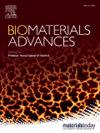Relation between shape-tailored CeO2 nanoparticles morphology and hemocompatibility and antimicrobial effect
IF 5.5
2区 医学
Q2 MATERIALS SCIENCE, BIOMATERIALS
Materials Science & Engineering C-Materials for Biological Applications
Pub Date : 2025-02-17
DOI:10.1016/j.bioadv.2025.214229
引用次数: 0
Abstract
Cerium is one of the most studied rare elements whose oxidative state (Ce3+ and Ce4+) can be changed in different environments. Cerium oxide nanoparticles (CeO2 NPs), which are nevertheless more complex chemical structures, are nowadays very exciting entities involved in the biomedical field, particularly in the four stages of wound healing. In the first stage, called hemostasis, several issues such as the required morphology to be biologically efficient, and the effect of Ce3+ and Ce4+ on the applicability potential of CeO2 NPs remain unclear. Our interest is focused in this study on the detailed understanding of the cations' location, when differently shaped CeO2 NPs (i.e., nanocube, nanosphere, nanorod, and polyhedral particles) were used. Additionally, the present research highlights the applicability of nanoparticles in direct contact with blood and the antibacterial and antifungal properties of the samples. A correlation between the fungicidal properties of the samples and the Ce3+ cations formed on the surface was performed. The nanosphere/nanorod particles show the highest interaction with the hemoglobin (Hb). In addition, it was concluded that negatively charged surfaces favor the antibacterial properties using gram-negative bacteria. The morphologies' applicability will depend on the following parameters: surface area/volume ratio, crystallinity, hydrophilicity, Ce3+/Ce4+ ion distribution, and surface charge. Considering all these parameters and the nanoparticle applications, the nanorod will be the most suitable for antimicrobiological applications (antibacterial and antifungal), and showing the highest hemocompatibility.

求助全文
约1分钟内获得全文
求助全文
来源期刊
CiteScore
17.80
自引率
0.00%
发文量
501
审稿时长
27 days
期刊介绍:
Biomaterials Advances, previously known as Materials Science and Engineering: C-Materials for Biological Applications (P-ISSN: 0928-4931, E-ISSN: 1873-0191). Includes topics at the interface of the biomedical sciences and materials engineering. These topics include:
• Bioinspired and biomimetic materials for medical applications
• Materials of biological origin for medical applications
• Materials for "active" medical applications
• Self-assembling and self-healing materials for medical applications
• "Smart" (i.e., stimulus-response) materials for medical applications
• Ceramic, metallic, polymeric, and composite materials for medical applications
• Materials for in vivo sensing
• Materials for in vivo imaging
• Materials for delivery of pharmacologic agents and vaccines
• Novel approaches for characterizing and modeling materials for medical applications
Manuscripts on biological topics without a materials science component, or manuscripts on materials science without biological applications, will not be considered for publication in Materials Science and Engineering C. New submissions are first assessed for language, scope and originality (plagiarism check) and can be desk rejected before review if they need English language improvements, are out of scope or present excessive duplication with published sources.
Biomaterials Advances sits within Elsevier''s biomaterials science portfolio alongside Biomaterials, Materials Today Bio and Biomaterials and Biosystems. As part of the broader Materials Today family, Biomaterials Advances offers authors rigorous peer review, rapid decisions, and high visibility. We look forward to receiving your submissions!

 求助内容:
求助内容: 应助结果提醒方式:
应助结果提醒方式:


